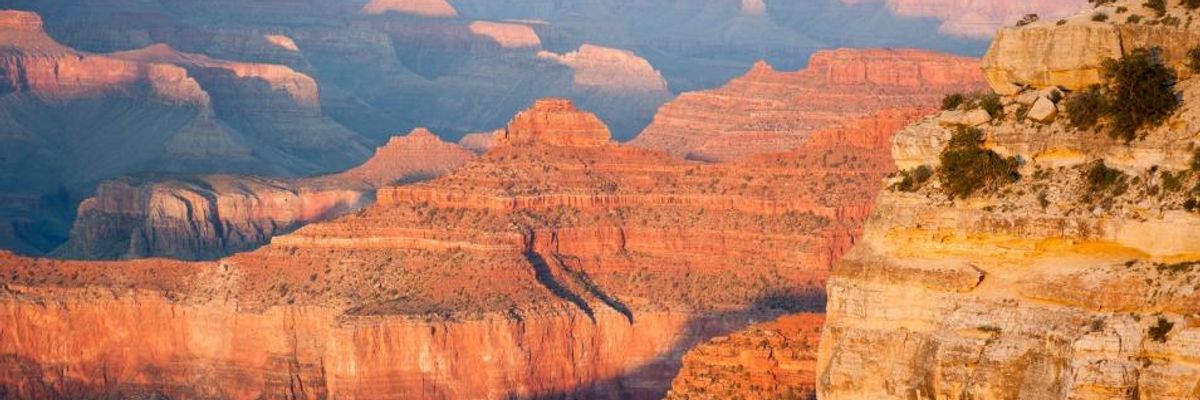This post has been updated from its original.
A grassroots campaign is calling on anyone who opposes a huge new development just a few miles from Grand Canyon National Park to make their objections known to local officials as the government of a nearby town prepares to vote on the building of a new housing, retail, and entertainment complex.
A Twitter thread by a grassroots activist called "Jack" went viral Monday, gaining more than 100,000 re-tweets in about 24 hours as users read about an Italian development company's plans to build a convention center, a spa, more than 2,000 homes, and potentially a water park just 10 miles from the beloved national landmark.
In addition to changing the landscape of the Grand Canyon's southern rim, the thread explained, the creation of such an expansive development would threaten the sole water source used by the local Havasupai Tribe.
"If any of my tweets ever go viral I hope it's this one," wrote Jack. "There's no national news coverage about this and some very rich people want to keep it that way."
Jack explained how the Italian development company Stilo Gruppo purchased land near the south rim of the Grand Canyon in 1990 and now hopes to move ahead with the long-planned development.
As Common Dreams reported in 2015, conservation campaigners earlier fought Stilo's attempt to obtain a permit to build a road cutting through Kaibab National Forest, the first stage of their development.
"The Forest Service is putting Grand Canyon National Park in the crosshairs by considering Tusayan's dangerous, damaging plan for a mega-resort," said Kevin Dahl of the National Parks Conservation Association (NPCA) at the time. "This proposal is not in the public interest and is one of the greatest threats Grand Canyon National Park has seen in its history."
As the NPCA wrote after the U.S. Forest Service eventually rejected Stilo's proposal, voters in the local county helped keep the company's plans from moving forward for decades.
"That all changed when the tiny gateway town of Tusayan (fewer than 600 residents) incorporated and annexed this land," said the NPCA. "In 2014, Tusayan approved zoning for Stilo to allow 2,176 residential units and three million square feet of retail space (equal to the size of 10 big box stores)."
The NPCA and other opponents warn that the Stilo development would destroy springs that provide drinking water that the Havasupai have lived on for hundreds of years.
"The only water currently available in Tusayan is groundwater, which is pumped from the aquifer that feeds ecologically and culturally important springs within Grand Canyon National Park," the NPCA explained after the earlier project was blocked in 2016. "More groundwater pumping would likely lower aquifer levels, damaging or drying up the springs. The aquifer is also the sole source of water for Havasu Creek. This creek is the lifeblood of members of the Havasupai Tribe, who rely on it for drinking and irrigation water."
Common Dreams' request for comment from Jack was unanswered at press time.
At a meeting planned for Wednesday, the Tusayan town council will discuss the building of 17 workforce homes, construction that would "[open] the door for Stilo to build the rest," Jack wrote.
Alicyn Gitlin, a conservation coordinator with Sierra Club's Grand Canyon Protection Campaign, told Common Dreams that the small housing development the town is discussing this week represents just a tiny portion of the larger development project that could "[alter] northern Arizona's landscape and the way people visit Grand Canyon in huge ways."
According to Gitlin, the town of Tusayan along with Stilo are "investigating repurposing a 270-mile coal slurry pipeline to provide water to the town and serve its new and proposed developments."
The pipeline "would require a valid, and as yet undisclosed, water right, would also require rights-of-way through Forest Service and Bureau of Land Management lands to complete its route from water source to the town of Tusayan," Gitlin said. "Pumping water uphill along the 270-mile line would require a tremendous amount of energy. In 2017, Grand Canyon National Park released a proposal for a new water pipeline to bring drinking water to the South Rim. Stilo and the town of Tusayan may be encouraging the park to obtain water from this pipeline, which will likely be owned by a foreign corporation."
"The town is expected to apply again for a right of way that would enable it to build a massive development at Tusayan within the next several months," Gitlin told Common Dreams.
On Twitter, Jack called on supporters of indigenous people and water rights to contact local officials in Tusayan to urge them to vote against approving Stilo's development.
"I beg you to care about this. The Grand Canyon has been a home to Indigenous Americans for over 800 years and a protected national park for 100 years," Jack tweeted.
This post has been updated and clarified to make clear that the town of Tusayan is expected to apply for rights it needs to move forward with the development in the coming months.

